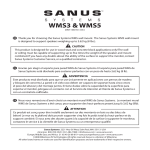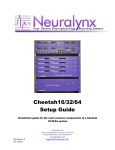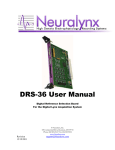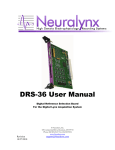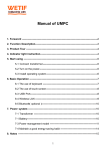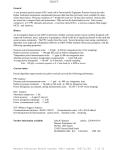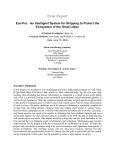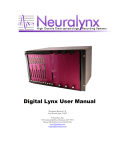Download ERP-27 User Manual
Transcript
ERP-27 User Manual Patch Panel Referencing Document Revision 1.21 Last Revised: April 20, 2009 Neuralynx, Inc. 105 Commercial, Bozeman, MT 59715 Phone 406.585.4542 • Fax 406.585.9034 www.Neuralynx.com [email protected] Table of Contents 1 2 3 4 Document Overview ................................................................................................... 3 ERP-27 Overview ....................................................................................................... 4 Front Panel .................................................................................................................. 5 Back Panel Overview .................................................................................................. 8 4.1 Headstage Modifications .................................................................................... 11 5 Mounting ................................................................................................................... 12 6 Cable Connection ...................................................................................................... 13 7 Using the ERP-27 ..................................................................................................... 17 8 About Banana Connectors ........................................................................................ 17 9 Normal Reference Setup ........................................................................................... 17 10 Using a Quiet Headstage Signal as Reference .......................................................... 18 11 Using Multiple Amplifier Settings on a Single Headstage Signal ............................ 20 12 Inputting Non-Headstage Signals into the ERP-27 .................................................. 21 13 Amplifier and Analog to Digital Channel Mapping ................................................. 22 14 Appendix A ............................................................................................................... 23 List of Figures and Tables Figure 3-1: ERP-27 Front Panel Overview ......................................................................... 5 Figure 4-1 Back Panel ......................................................................................................... 8 Figure 4-2: Power Connection Pin Breakout ...................................................................... 9 Figure 4-3: Stimulus Connection Pin Breakout ................................................................ 10 Figure 4-4: Headstage Tether Connection Pin Breakout .................................................. 11 Figure 5-1: Rack Mount Screw with Nylon Washer ....................................................... 12 Figure 5-2 ERP Rack Mounted ......................................................................................... 13 Figure 6-1: Power Supply Cable (PSC) connection ......................................................... 14 Figure 6-2: Normal Power On for ERP-27 ....................................................................... 14 Figure 6-3: J-AMP cable connections ............................................................................... 15 Figure 6-4: L8 Amplifier connections .............................................................................. 15 Figure 6-5: Tether Adapter Micro..................................................................................... 16 Figure 6-6: Tether Adapter Connected ............................................................................. 16 Figure 9-1: Typical Reference Setup ................................................................................ 18 Figure 10-1: Using a quiet channel as reference ............................................................... 19 Figure 11-1: Using a signal multiple times ...................................................................... 20 Figure 12-1: Inputting an external signal and reference. .................................................. 21 Table 1 Signal Descriptions ................................................................................................ 6 Table 2 Indicator LEDs ....................................................................................................... 7 Table 3 Stimulus Breakout Table ..................................................................................... 10 Table 4 HS Stim Plug Requirements ................................................................................ 11 Table 5 ERP Rack Mounted ............................................................................................. 13 Table 6 Cheetah 16 ........................................................................................................... 22 Table 7 Cheetah 32 ........................................................................................................... 22 Table 8 Cheetah 64 ........................................................................................................... 23 Neuralynx, Inc. ERP-27 User Manual Rev 1.21 Last Revised: April 20, 2009 Page 2 1 Document Overview This manual is intended as an overview of the 27 channel Electrode Reference Panel (ERP-27). It will describe intended usage practices as well as general product operation and troubleshooting. It is not recommended that you use this product in a manner not described in this manual. Improper use of this product can damage your equipment or cause the death of your test subject. If your situation requires special usage of the ERP27, contact Neuralynx to make sure your setup will not cause any unintended side effects. Neuralynx: 406.585.4542 [email protected] Neuralynx, Inc. ERP-27 User Manual Rev 1.21 Last Revised: April 20, 2009 Page 3 2 ERP-27 Overview The ERP-27 provides the central connection point and controls for: The electrode headstage preamp Four Neuralynx Lynx-8 Amplifiers Eight external user input signals (with reference inputs) Five configurable global references Two bipolar external Stimulus Isolation Units (SIU) The ERP-27 provides an intuitive and flexible user controlled selection of reference sources and reference selection for system amplifier inputs. This device is designed to interface to the Neuralynx HS-27 series of headstage preamps. The 27 channels on the HS-27 are active buffered electrode input channels which are commonly classified as 24 input electrodes with two extra EEG channels and one reference electrode channel. The ERP-27 interfaces to four Neuralynx Lynx-8 (L8) amplifiers (32 channels total). The 24 single unit electrode signals are routed directly to the 24 signal inputs of the first three amplifiers. The fourth L8 amplifier is connected to the Continuously Sampled Channel connection area on the ERP-27. This allows a very convenient method for amplifying and filtering the same electrode signal with different gains and filter settings, for example, to record both single unit activity (high frequency bandpass and large amplification) and EEG (low frequency bandpass and lower amplification) from one electrode. This allows for eight of the electrode signals to be conveniently recorded in this manner (more on this later). Neuralynx, Inc. ERP-27 User Manual Rev 1.21 Last Revised: April 20, 2009 Page 4 3 Front Panel Figure 3-1: ERP-27 Front Panel Overview Headstage Signal Outputs: These banana jacks provide an output for the unity gain buffered signals from the headstage. In addition to outputting the headstage signal through these banana jacks, the ERP-27 is hard wired to send the signal to the L8 amplifiers. Using these outputs does not affect the signal being sent to the amplifiers. These connections are most commonly used for monitoring headstage signals on an external device (i.e. oscilloscope), or for connecting to one of the signal inputs on the ERP-27. The labeling on the ERP is designed to mimic the labels on the electrode interface board (EIB) used with the HS-27. The signal name can be determined by taking the letter to the left of the row of banana jacks and appending the number underneath the banana jack. Example: The leftmost banana jack on the top of the ERP-27 corresponds to the A1 signal from the headstage. Headstage Signal Reference Selectors: These five position slide switches are used to select the reference signal for the corresponding headstage channel (the banana jack above the switch). The switch positions (A, B, C, D, E) correspond to the Panel Reference Inputs. The headstage signal will be sent with the reference signal to the input of the L8 amplifier for conditioning and amplification. Example: If you position the reference selector switch under the A1 banana jack to D, the ERP will send the signal from the headstage on A1 along with the signal that is being input into D to the L8 amplifier. The amplifier will amplify and output the difference between A1 and D to send a single signal to the computer for acquisition. NOTE: If there is no signal present on the selected reference, the headstage input will be referenced to whatever input noise is present on the Panel Reference Input banana jack. Panel Reference Inputs: These banana jack inputs determine the signals used for reference selections A,B,C,D and E throughout the ERP-27. You may connect any signal (max: 20V, min: -20V) to these inputs. However, these inputs are most commonly connected to the Extra Headstage Signal Outputs directly below each Panel Reference Input (ARef, BE1, CE2, DAGnd, EPGnd). These connections can be made with the short banana plug jumpers generally shipped with the ERP-27. Neuralynx, Inc. ERP-27 User Manual Rev 1.21 Last Revised: April 20, 2009 Page 5 Extra Headstage Signal Outputs: As explained in the ERP-27 overview, our 27 channel headstages actually have two extra EEG signals and one extra reference signal that are sent from the headstage to the ERP-27. The fourth signal AGnd will be explained below. These extra signals are output through the banana jacks. Unlike the Headstage Signal Outputs, the ERP-27 is not hard wired to send these signals to the L8 amplifiers. Although these signals can be used for other purposes, the general usage is as follows: Table 1 Signal Descriptions Signa l Description Reference electrode. This is generally an inactive area of the brain that can be used to Ref subtract the brain's background noise from the other electrodes. Extra EEG channel #1. Can be used to either monitor a signal that will not be used for E1 recording, or for a signal that is present in surrounding electrodes that you wish to subtract via referencing. E2 Extra EEG channel #2. Same as E1. This is the HS-27 ground, commonly referred to as Animal Ground. This signal is carried on a dedicated, non-current carrying conductor directly from the HS-27 through AGnd the tether cable to the ERP-27. This is intended to be the best representation of the voltage on the HS-27 ground and the animal skull. Panel Ground: These banana jack outputs allow you to reference to the ERP-27’s internal ground. The PGnd signal is generally used for signal referencing and connected to the E panel reference input. The other two banana jacks provide a convenient connection for antistatic wrist straps when working with any static sensitive electronics, or directly to test subjects to avoid static discharge to exposed electrode connections. NOTE: These connections should not be used as a current sink. Current running into these connections may cause unwanted voltage offsets for other signals on the ERP-27. Power Control: Turns the power on the ERP-27 off and on. Neuralynx, Inc. ERP-27 User Manual Rev 1.21 Last Revised: April 20, 2009 Page 6 Panel Status Indicators: These LEDs provide information about the current status of the ERP-27. The indicator LEDs are defined below: Table 2 Indicator LEDs Indicator Label GREEN V+ +5V Power on the ERP-27 is on. V- -5V Power on the ERP-27 is on. I+ I- Normal current flow in +5 V power supply when ERP-27 is on. Normal current flow in -5 V power supply when ERP-27 is on. RED Over current detected in the +5V power supply. Over current detected in the -5V power supply. OFF +5V Power on the ERP-27 is off -5V Power on the ERP-27 is off. + 5V Power on the ERP-27 is off.* -5V Power on the ERP-27 is off.* Fuse for the +5V power +5V fuse is in supply is blown or not tact and present. present.** Fuse for the -5V power +5V fuse is in Fault(lower) supply is blown or not tact and present present** *The I+ and I- indicators may normally glow dimly even when an HS-27 is not connected to the ERP-27. Fault(upper ) ** I+, I-, V+, and V- will turn off when a fault is detected. Neuralynx, Inc. ERP-27 User Manual Rev 1.21 Last Revised: April 20, 2009 Page 7 CSC Signal Inputs: These banana jacks allow you to input any signal (max: 20V, min: -20V) into the system. Signals connected to these inputs will be treated as if they had come directly from the headstage. This will be useful for recording signals that do not come from the headstage (i.e. a stimulus signal) or allow you to record one of the headstage signals with different amplifier settings. One misconception is that these inputs are related to the continuously sampled channels (CSC) in the Cheetah software, this is not so. The CSC inputs on the ERP-27 are signal inputs only; they are treated identically to the regular headstage signals in the Cheetah software. CSC Reference Selectors: The reference selectors for the CSC inputs are identical to the headstage reference selectors with one exception: they have a sixth position for an external reference signal. This external signal is obtained from the External Reference Input directly beneath the selector switch. External Reference Inputs: The external reference inputs function identically to the Panel Reference Inputs. However, the external reference input is only connected to the selector switch that is directly above the banana jack. It is not routed through the entire panel as the panel references are. You may wish to use these inputs if you are recording a differential stimulus or a signal that has its own reference that differs from any of the other references already connected to the ERP-27. 4 Back Panel Overview Figure 4-1 Back Panel Power Connection: The ERP-27 is designed to be powered from the Lynx-8 Power Supply (L8PS), sold separately. The power input circuitry on the ERP-27 provides headstage voltage regulation and current monitoring. The headstage power application is electromechanically delayed for 20ms after both the + and – 5V power supplies become fully charged. The ERP-27 uses the same power connection as the L8 amplifiers. The pin breakouts are as follows: Neuralynx, Inc. ERP-27 User Manual Rev 1.21 Last Revised: April 20, 2009 Page 8 Figure 4-2: Power Connection Pin Breakout +5V Fuse and -5V Fuse: These fuses are used to protect the ERP-27 circuitry from electrical surges. If either of these fuses needs replacing, please use 250mA, 250V, fast blow fuses. When a fuse has blown, the corresponding Fault indicator on the front of the panel will turn red. Neuralynx, Inc. ERP-27 User Manual Rev 1.21 Last Revised: April 20, 2009 Page 9 Stimulus Connections: This 10 pin connector contains the two differential stimulus channels that are connected through the tether and headstage to the electrode interface board (EIB). The stimulus channels are designed for delivery of an isolated current to a separate stimulus electrode. These four signals are connected to the EIB without any other connections to avoid interference with stimulus signal delivery. The ERP-27 is usually shipped with a stimulus plug connected to this socket. The stimulus plug is a resistor pack that shunts the headstage power to the stimulus pins. The resistors are placed at the ERP-27 to give current limiting protection in the event of tether damage (i.e. an animal chewing through the tether). With the stimulus plug in place, the headstage power being sent down the tether can be used to power LEDs for use with a CheetahVT video tracking system (please refer to Headstage Modifications and Table 4 for updated information on this section of the ERP-27). WARNING: When connecting the stimulus channels to a stimulus electrode in the brain, the stimulus plug MUST be removed before turning on the ERP-27 power. Failure to remove the stimulus plug may cause your subject to sustain permanent brain injury or death. The pin breakout of the stimulus connector is as follows: Figure 4-3: Stimulus Connection Pin Breakout Table 3 Stimulus Breakout Table Pin 1 2 3 4 5 6 7 8 9 10 Label S1SRC S1RET S2SRC S2RET NC NC NC NC +5V -5V Description Source stimulus signal #1. Return stimulus signal #1. Source stimulus signal #2. Return stimulus signal #2. Not connected. Not connected. Not connected. Not connected. +5V Headstage Power -5V Headstage Power Neuralynx, Inc. ERP-27 User Manual Rev 1.21 Last Revised: April 20, 2009 Page 10 4.1 Headstage Modifications Recently, a new revision of the Neuralynx Headstages was released with a modified board layout of the Stimulation and Video Tracking traces. In the past, a stimulation plug was needed to power all Video Tracking LED’s on the Headstages. The HS-36 and the HS-18 Cooner were modified so that this plug is no longer needed. If you have an older revision Headstage, please continue to use the stim plugs as before. Please refer to Table 4 for reference. Table 4 HS Stim Plug Requirements Headstage (HS) STIM Plug Requirements for Video Tracking LED’s HS-36 HS-27 HS-18 Cooner/FWT HS-36 STIM Plug needed HS-27 STIM Plug Needed HS-36 STIM Plug needed on Revision 2.0 or earlier on all HS’s on Revision 2.0 or earlier Headstage Tether Connection: This connector is a 50 pin 3M MDR style connector. The tether is connected to this connector through a tether adapter (sold separately) that will convert the Micro-DB37 tether connection to the 3M MDR connection. This connection should always be used with a Neuralynx supplied connector, the pin breakout is provided for informational purposes only. Figure 4-4: Headstage Tether Connection Pin Breakout All the descriptions of the labels are discussed elsewhere in this document. The X# and Y# labels correspond to A# and B# headstage signals respectively. Neuralynx, Inc. ERP-27 User Manual Rev 1.21 Last Revised: April 20, 2009 Page 11 Headstage Signal Outputs: These three 20 pin connectors are labeled JAMP1, JAMP2, and JAMP3 from top to bottom. These connectors output both the headstage signal and its selected reference signal. The headstage signal outputs are designed to connect directly to the front Input connector of a L8 amplifier. The headstage signal outputs are hard wired and cannot be changed. They are mapped as follows: Connector JAMP1 JAMP2 JAMP3 Headstage Signals A1 A8 A9 A12, B1 B4 B5 B12 CSC Signal Outputs: This 20 pin connector, labeled as JAMP4, is dedicated to the eight CSC inputs on the front of the ERP-27. This connector outputs both the CSC input signals and their selected reference signal. This output is designed to connect directly to the front Input connector of a L8 amplifier. The signals on this output are hard wired and cannot be changed. This chapter will take you through the setup process for the ERP-27. Since the ERP-27 relies on other Neuralynx products to operate correctly, you may see references to other products that you might not necessarily possess. This guide will reference the most common components used with the ERP-27, if your components differ from those mentioned, please see the documentation for your specific products. If you have questions about obtaining any of the products mentioned in this section, please contact Neuralynx for more information. 5 Mounting The ERP-27 is designed to fit into a standard 19” rack mount system. It is assumed that you have purchased an appropriate rack and mounting hardware separately. It is highly recommended that the ERP-27 be rack mounted. Use of nylon washers between the mounting screws and the Neuralynx equipment faceplate will prevent scratching of the faceplate paint. If you do not have this equipment, please contact Neuralynx for information on obtaining rack mount hardware. Figure 5-1: Rack Mount Screw with Nylon Washer Neuralynx, Inc. ERP-27 User Manual Rev 1.21 Last Revised: April 20, 2009 Page 12 The number of ERP-27s will vary depending on your Cheetah system. This diagram shows a Cheetah32 setup with one ERP-27. The ERP-27 should be mounted at the top of the rack system using four screws as shown. When mounting L8 amplifiers beneath the ERP, please ensure a 1” gap between the bottom of the ERP and the topmost L8. Table 5 ERP Rack Mounted Figure 5-2 ERP Rack Mounted 6 Cable Connection Cable connection is the most important part of the end user setup process. If the ERP-27 is not cabled properly, you may have poor referencing and possibly unusable signals leaving the ERP. No error logs can be used to determine cabling issues, so please read this section carefully. NOTE: Make sure that the L8PS is turned OFF while making cable connections. Neuralynx, Inc. ERP-27 User Manual Rev 1.21 Last Revised: April 20, 2009 Page 13 Step 1: Testing Lynx 8 Power Supply Cable Connection and From the Lynx 8 Power supply, connect the PSC five pin (three wire) connector to the ERP power connection (labeled +15 -15 Gnd) on the back of the ERP board. Figure 6-1: Power Supply Cable (PSC) connection Turn ON the Power Supply, then turn ON the ERP. Verify that the power supply LEDs labeled +15 OK and -15 OK and the ERP LEDs labeled +V, -V, +I, and –I are all green. Turn OFF the ERP and then turn OFF the power supply. Figure 6-2: Normal Power On for ERP-27 Neuralynx, Inc. ERP-27 User Manual Rev 1.21 Last Revised: April 20, 2009 Page 14 Step 2: ERP AICA Cable Connection On the back of the ERP are four male 20 pin connections, connect the ERP AICA cable (the end labeled J-AMP#) to these connections. Connection 1 will be the TOPMOST of these male connections. The other end of the ERP AICA cable (labeled AMP #) should be connected to the corresponding input (labeled Input) of the Lynx 8 amplifier number (the bottom most amplifier is number 1). Figure 6-3: J-AMP cable connections Figure 6-4: L8 Amplifier connections For systems without four L8 amplifiers per ERP-27, remember that the signals being output through the JAMP1 – JAMP4 connectors are hard wired and cannot be changed. Use the descriptions of the Headstage Signal Outputs and CSC Signal Outputs from Neuralynx, Inc. ERP-27 User Manual Rev 1.21 Last Revised: April 20, 2009 Page 15 Step 3: Headstage Tether Connection The ERP-27 can be used with a variety of headstages offered by Neuralynx. For the purpose of this setup, we are using a HS-27. Other headstages will mount similar to this headstage, if you have any problems connecting your specific headstage, please see the documentation provided with your headstage, or contact Neuralynx. Using a headstage to tether adapter: Figure 6-5: Tether Adapter Micro Connect the headstage’s tether to the 37 pin connector on the tether adapter. The 50 pin connector should connect to the Headstage Tether Connection on the back of the ERP-27 as shown below: Figure 6-6: Tether Adapter Connected The ERP-27 is now ready to use. There are other steps required to use the complete Cheetah Acquisition System, but they will not be covered in this manual. Please see the appropriate documentation for your system for more details. Neuralynx, Inc. ERP-27 User Manual Rev 1.21 Last Revised: April 20, 2009 Page 16 7 Using the ERP-27 After you have the Cheetah Acquisition Hardware and Software running, you will need to be able to use the ERP-27 in order to actually record signals. There are many things that the ERP-27 can do other than simply pass signals from the headstage to the L8 amplifiers. In this chapter we will show you what a generic setup looks like, as well as some of the common advanced setup techniques. WARNING: Using the ERP-27 in ways not described in this manual is not recommended, please contact Neuralynx before using any non-standard setup. 8 About Banana Connectors The banana connector wires are assembled without soldering the wire to the metal banana plug. The un-insulated end of the wire is inserted through the center of the metal plug body and the plastic cap is screwed on which, when tightened, secures the end of the wire to the metal plug body. This method reduces the overall cost and provides you the flexibility of changing the wire in a very simple manner. Because of this, the banana plug plastic cover may become inadvertently loosened if you remove the plugs with a counter-clockwise twisting motion. Therefore we advise you to make a habit of applying a slight clockwise force when inserting and removing the plugs from the panel jacks. This slight force should not be enough to cause the banana plug body to rotate within the panel jack. Using strong twisting force on the banana wires will cause long term damage to the interior metal connection pieces. 9 Normal Reference Setup Although the ERP-27 allows you to use any signal as a reference, we have found that there is a setup that tends to provide the best noise reduction. This setup simply involves connecting the Extra Headstage Inputs and PGnd to the Panel Reference Inputs with the provided small banana jumpers as shown below: Neuralynx, Inc. ERP-27 User Manual Rev 1.21 Last Revised: April 20, 2009 Page 17 Figure 9-1: Typical Reference Setup The Headstage Signal Reference Selectors should generally be in the A position, as this signal is usually the best representation of the normal background noise signals present. The D, or AGnd, reference signal is best used in the following situations: Using the HS16 headstage, which does not have a specific Ref channel. All other available reference electrodes have increased in impedance or have gone bad. All references have single unit activity. When using AGnd, be aware that this signal is not buffered by the headstage. If you need to use this signal as a reference, it is a good idea to route the AGnd signal on the EIB through E1 or E2 on the EIB and then use the E# signal as the reference. These settings are suggested based on the majority of experiences; your typical referencing may need to be different. Try experimenting with reference selection in your system to find out what gives you the best results. NOTE: It is possible to position a selector switch between reference selection positions. This is because the switches do not connect between positions, which ensure that the reference sources will not be shorted during selector switch operation. Therefore, make sure that when a switch is moved that you do not leave the switch positioned between reference sources. If this happens this will leave the reference to the respective headstage signal open (not connected to any reference source) and the result will be a very noisy recording channel at the output of the amplifier. 10 Using a Quiet Headstage Signal as Reference When all of the typical reference signals do not reduce noise to a point where your input signals are usable, you need to look elsewhere for reference selection. The ERP-27 provides this flexibility. If after looking at the activity of the implanted electrodes, you notice a headstage signal that seems to have no activity, you might want to try using this channel as reference. Below is a typical deviation from the standard reference setup. In this example, A1 is the quiet channel that we wish all other channels to reference. The lines indicate banana plug connections, the dots indicate switch position. Only the A# signals from the headstage are shown with the appropriate reference selection. Neuralynx, Inc. ERP-27 User Manual Rev 1.21 Last Revised: April 20, 2009 Page 18 Figure 10-1: Using a quiet channel as reference In this configuration, all of the A# signals from the headstage will be referenced to the signal present on A1 when sent to the L8 amplifiers. The output of the L8 amplifiers will be the headstage signal minus A1, amplified. This means that there will be no amplified A1 signal, as it is referenced to itself. Neuralynx, Inc. ERP-27 User Manual Rev 1.21 Last Revised: April 20, 2009 Page 19 11 Using Multiple Amplifier Settings on a Single Headstage Signal The ERP-27 is hard wired to only give one output for each headstage signal. This only allows for one amplifier setting per headstage signal. If you want to record the data for a single headstage signal using multiple amplifier settings (i.e. to record a signal using narrow band filters for spikes, and wide band filters for CSC), you will need to make use of the CSC Signal Inputs. Banana wires and switch positions are denoted the same way as in the last example. Only relevant connections for the scope of this example are shown. Figure 11-1: Using a signal multiple times In this example, we want to record A12 as a spike channel, a narrow band CSC (to show all the data between spikes), and a wide band CSC (to show unfiltered data coming in on A12). All we have to do in order to accomplish this task is to make a banana wire with three connectors and connect the cable between A1, CSC1, and CSC2. Just to show that it is possible, we are referencing CSC2 to C instead of A. As far as the ERP is concerned, anything plugged into one of the CSC inputs is a completely separate signal. The only thing you need to remember about this setup is that CSC1 and CSC2 are going to be output through JAMP4 in the back of the ERP-27, whereas A12 will be output through JAMP2. Once you have the Cheetah software setup to recognize these signals, you can set the L8 amplifiers to filter all of these signals in different ways. You can see the help file in the Cheetah software for more information on writing Cheetah configuration files. Neuralynx, Inc. ERP-27 User Manual Rev 1.21 Last Revised: April 20, 2009 Page 20 12 Inputting Non-Headstage Signals into the ERP-27 Sometimes it might be desirable to record an external signal along with all your neurodata for experiment monitoring purposes (i.e. a differential stimulus signal). This can be done using the CSC Signal Inputs. Many external signal generators have their own reference, so you will need to make use of the External Reference Inputs. Figure 12-1: Inputting an external signal and reference. Connecting the external signal to the CSC1 input and the external reference under CSC1 as shown above will allow your external signal to be filtered by the L8 amplifiers and make the signal visible in the Cheetah software. You need to make sure the reference selector switch is in the bottom position in order to reference to the external reference signal. Neuralynx, Inc. ERP-27 User Manual Rev 1.21 Last Revised: April 20, 2009 Page 21 13 Amplifier and Analog to Digital Channel Mapping When configuring Cheetah, it is very important to know how the electrodes in the brain, relate to the ERP channels and the computer’s A/D channels. On all headstages, there are labels corresponding to the ERP channels (i.e. A1 on the headstage maps to A1 on the ERP). The confusion comes when moving from the ERP channels to the A/D channels. The most important thing to remember is that the A/D channels are a property of the amplifier, NOT the ERP. When connecting the Cheetah 32 Analog Cable to an amplifier, you are setting the A/D channel for that amplifier. When setting up the amplifiers as described in this guide, you will always have channels 0-7 on the bottom amplifier, 8-15 on the 2nd to bottom, etc. No matter what connection your amplifier has to the ERP, the A/D channel values will not change. The mapping between the A/D channels and your displays can be found in your electrode setup file. The electrode setup file that is currently being used by your system is the only uncommented (no #) line in the electrode setup section of the Cheetah.cfg file. Both the electrode setup file and Cheetah.cfg file are located in your C:\Program Files\Neuralynx\Cheetah directory. For more information on setup files, see Setup File Command Reference under Cheetah’s Help menu. Standard setups for the systems in this guide are as follows: These tables should be read as: If you have ERP Connection connected to the front of Amplifier Number then ERP Channels map to Analog to Digital Channels. Table 6 Cheetah 16 Amplifier Number 2 1 ERP Channels SEE NOTE SEE NOTE ERP Connection SEE NOTE SEE NOTE Analog to Digital Channels 8 - 15 0-7 NOTE: Cheetah16 systems do not have pre-assigned ERP channels. They can have any two of the Cheetah 32 ERP channels assigned to the two amplifiers by changing the JAMP# connection to the back of the ERP. Remember, the ERP connection has nothing to do with the A/D channel, the A/D channel is determined by the amplifier that the ERP is connected to. Table 7 Cheetah 32 Amplifier Number 4 3 2 1 ERP Channels CSC1 - CSC8 B5 - B12 A9 - B4 A1 - A8 ERP Connection JAMP4 JAMP3 JAMP2 JAMP1 Neuralynx, Inc. ERP-27 User Manual Rev 1.21 Last Revised: April 20, 2009 Analog to Digital Channels 24 - 31 16 - 23 8 - 15 0-7 Page 22 Table 8 Cheetah 64 Amplifier Number 8 7 6 5 4 3 2 1 ERP Channels (ERP #) CSC1 - CSC8 (2) CSC1 - CSC8 (1) B5 - B12 (2) A9 - B4 (2) A1 - A8 (2) B5 - B12 (1) A9 - B4 (1) A1 - A8 (1) ERP Connection (ERP #) JAMP4(2) JAMP4(1) JAMP3(2) JAMP2(2) JAMP1(2) JAMP3(1) JAMP2(1) JAMP1(1) Analog to Digital Channels 56 - 63 48 - 55 40 - 47 32 - 39 24 - 31 16 - 23 8 - 15 0-7 14 Appendix A An Example (using setup from Figure 10-1): For this example we have a system with an ERP-27 but only a single amplifier. Let us assume that you have a single electrode in the brain whose wire connects to A1 on the headstage. The A1 signal on the headstage will connect to the A1 channel on the ERP. Now, you would like to see the A1 signal show up as both a spike channel and also a continuous sampling so you can monitor the signal as an EEG inside of Cheetah. Since the ERP automatically maps A1 to the JAMP1 connector on the back of the ERP, this only gives you one way to get the signal A1 out of the ERP. I digress from our example for a quick look at the ERP’s CSC connections. If you look at any headstage, you will notice that it does not contain any channels labeled CSC, this is because the CSC channels of the ERP are designed to be able to input any external signal into Cheetah. If there is nothing plugged into the banana connectors on the front of the ERP, there will be NO signals on any of the CSC channels leaving the ERP. ERP channels CSC1-CSC8 always map to the JAMP4 connector on the back of the ERP. Back to the example. “So,” you may ask, “if I’m interested in the signal on A1, why even talk about the CSC inputs?” Good question. Remember that we want to view the signal on A1 in two different ways, but there is only ONE A1 signal output from the ERP and it does so through JAMP1. In order to get A1 out of the system as TWO different signals we need to make use of the ERP’s CSC channels. Since the ERP’s CSC channels can accept any signal input through their banana connections, we can utilize the banana connector under A1 to connect A1 to one of the CSC connections. Let us use CSC1. Ok, now we have A1 connected to CSC1. This now gives us TWO signal outputs for A1: through the normal A1 output on JAMP1 and through the CSC1 output on JAMP4 (remember, these mappings are hard wired into the ERP and cannot be changed). Great! Except that we only have one amplifier, and can Neuralynx, Inc. ERP-27 User Manual Rev 1.21 Last Revised: April 20, 2009 Page 23 only connect it to either JAMP1 or JAMP4. Don’t worry, we are not thwarted, we still have seven more CSC inputs we can make use of. Doing a bit of wire cutting and splicing we can turn the two headed banana cable into a three headed banana cable. Now we can connect the three heads of the cable to A1, CSC1 and CSC2. This gives us THREE outputs for A1. However, this time we have two signals on the same ERP output cable, CSC1 and CSC2 both leave the ERP through JAMP4. If we connect JAMP4 to the front of our amplifier, we can now use those two signals inside of Cheetah. If you have connected your amplifier as described in this manual, the first two channels leaving your amplifier will be A/D channels 0 and 1, which just happens to now contain CSC1 and CSC2 respectively. Now it is just a matter of configuring your electrode setup file to use those signals appropriately. Which if you don’t know how to do, I suggest you take a look at some electrode configuration files, and read the Setup File Command Reference help file under Cheetah’s help menu. The main point of this example is that you should not associate what is written on the front of the ERP with what is shown in Cheetah. Just because it says CSC on the ERP does not mean it will be a CSC inside of Cheetah. Neuralynx, Inc. ERP-27 User Manual Rev 1.21 Last Revised: April 20, 2009 Page 24
























